Victoria Hospital for Children
Tite Street, Chelsea, SW3 4JX
Medical dates:
Medical character:
1866 - 1964
Specialist
In February 1866 a meeting was held at 118 Warwick Street, Pimlico, the residence of Dr Edward Ellis, to discuss the urgent need for a children's hospital. It was decided that suitable premises would be chosen in the neighbourhood of King's Road, Chelsea, and that the new hospital would be called the South London Hospital for Children.
Various premises were inspected and Gough House, a large mansion built in 1707, in Queens Road West was eventually leased at a rent of £65 a year. The Committee met at the house for the first time in October 1866 and decided the name of the establishment would be the South Western London Hospital for Children.
An Out-Patients Department opened on 5th November, when the Hospital had been renamed the Victoria Hospital for Sick Children. Patients attended not only from the Chelsea area, but also from all over London. Children up to the age of 16 years were seen. The Hospital's motto was Deo favenie, tandem fit surculus arbor (God willing, a shoot at length becomes a tree).
In April 1867 six in-patient beds were provided for children aged between 3 and 12 years. The following year the number of beds had increased to 32.
In 1873 the Hospital Committee bought the freehold of Gough House for £1500. The Hospital accommodation was rearranged internally, with a new Out-Patients Department with its own entrance in the basement. A baby ward was located on the ground floor and a ward set aside for those with "Hooping Cough". New wards opened in 1874, after which girls up to the age of 16 years were admitted. Around this time the Committee was holding negotiations with the Belgrave Hospital for Children (then in Cumberland Street, Pimlico), with a view to amalgamation, but nothing came of this. In 1876 the building was closed while it was re-roofed and extended. The Hospital then had 10 extra cots and an operating theatre, and some accommodation for the nursing and domestic staff. A fire-proof staircase was installed. The Hospital was officially reopened in May by Princess Louise (Marchioness of Lorne) who had a ward named after her. Later, Princess Alice (Princess Louis of Hesse) visited, and also had a ward named after her.
The Hospital had convalescent cots for its patients in a home
in Sydenham but, in 1876, a Mr Dalton offered a large house in Margate
to the Hospital for use as a convalescent home and "Churchfield" opened
in July, with 7 cots.
In 1877 the Metropolitan Board of Works planned a new street to run
from Queens Road to the Embankment (Queens Road was later renamed Royal
Hospital Road to distinguish it from all the other Queens Roads).
The new street was named Tite Street, after Sir William Tite, MP,
Chairman of the Metropolitan Board of Works.
The Board of Works offered land adjacent to the Hospital on
building leases and, the Hospital Committee, realising its open
position was coming to an end, bought land to the back and front of the
Hospital, that is towards the river and the main road, to minimize the
encroachment of any properties.
In 1879 the Hospital had to close for two months due to a typhoid
epidemic. The drainage system was renewed and an isolation ward
with two beds was set up in a single-storey block.
In June 1885 the foundation stone for a new Out-Patients
building was laid by Princess Louise. The new wing was opened by
the Prince and Princess of Wales,
accompanied by their three daughters. The ground floor of the
building contained a waiting hall and consulting rooms for
out-patients, and a dispensary; an adjacent shed provided shelter for
perambulators. The three upper floors contained a Nurses' Home
with 30 bedrooms (many nurses had previously lived in houses nearby).
A covered walkway was built later to connect the new building to
Gough House.
In 1890 the Hospital took over and absorbed the St Gabriel Home for
Infants, which had been founded in 1885. A plot of land was
bought in Stone Road, Broadstairs, Kent for a new Convalescent Home
for 40 children (this was opened in 1892 by Princess Louise). The
original convalescent home in Margate continued in use as a long-term
children's hospital, for those cases deemed unsuitable for treatment in
Tite Street.
In 1898 the Hospital was forced to close again, due to a diphtheria epidemic. Plans were made for a new in-patients building to be erected to the north of Gough House, which would house 104 in wards of not more than 16 beds each. £25,000 was needed, of which the Zunz charity contributed £5,000. The contract was eventually signed, by which time the cost of the building had risen to £30,779.
The new building opened in 1903. It had three floors of paired wards with 16 cots each, and 8 beds in the new isolation block on the top floor. There was an X-ray Department, an operating theatre and a clinical laboratory. The kitchen and dining room were in the basement, as were the storerooms. The first pair of new wards opened in March 1904, with patients transferred from the old building, and the second pair opened the following month. Gough House was then remodelled to provide administration offices and accommodation for the Resident Medical Officers. An extra storey was added to the building and an entrance made in Tite Street. By 1905 all the work had been completed. Queen Alexandra visited, and the sixth ward, paired with the Annie Zunz Ward, was named after her. The Hospital, which had dropped the word 'Sick' from its title, to become the Victoria Hospital for Children, then had over 100 beds.
During WW1 the Hospital suffered from a shortage of Resident Medical Officers, with the result that two wards had to be closed. In 1915 the closed wards with some 80 beds were offered to the War Office and were used by the 2nd London General Hospital. In 1916 the wards were restored as children's wards. In 1917, because of the shortage of nurses, the Broadstairs Convalescent Home had to be partially closed.
In 1921 the house next door to the Hospital, 29 Tite Street,
becane vacant and was put up for sale. The Committee bought it,
despite grave misgivings about how to pay off the debt. But luck
was on their side, as the Daily Mirror organised a Princess Mary Wedding Gift Appeal to commemorate her marriage. The proceeds of the Appeal were split between the Hospital for Sick Children
in Great Ormond Street and Tite Street; both received over £5,000
each. The premises at No. 29 Tite Street were adapted and, in
November 1922, the Prince of Wales opened the new Princess Mary Home
and Physiotherapy Department. The Home, for private patients, had
two wards, one named after the Prince of Wales and the other after the
Daily Mirror, and an operating theatre. The Hospital then had 138
beds.
In 1926, to celebrate the Hospital's Diamond Jubilee, a Mr William
Shepherd provided and furnished a Tonsils and Adenoids Ward, where
patients could stay for 24 hours after their operation.
In 1937 three isolation cubicles were set up for patients requiring intensive nursing care.
In 1939, at the outbreak of WW2, the Out-Patients Department was taken
over by the Chelsea Borough Council for use as a First Aid Post and
Decontamination Centre (gas attacks were expected as in WW1).
However, a paediatric casualty service was established in another
part of the ground floor. Many incendiaries fell on the Hospital
and, in 1940, a delayed action bomb fell under the outer wall of the
Out-Patients building. It was rendered innocuous, but soon
afterwards another bomb fell through the roof of the same building and
through several floors, causing devastating damage. The
dispensary was wrecked and the cylinders in the oxygen store were
flattened, but the bomb failed to explode. Following this event
the in-patients were sent away to the EMS Hospital at Windsor and to
Park Prewett Hospital in Basingstoke. Only six staff members
remained behind. The damaged rooms of the Out-Patients building
were eventually repaired and reopened, as was the first floor of the
main building. Apart from the shortage of staff during the war,
the Hospital suffered loss of revenue from its subscribers, who had
moved away. The Convalescent Home in Broadstairs, which had been
extended to 74 beds and was known as the Victoria and Zachery Merton
Convalescent Home, also had to close during the war due to bomb damage,
although the porter remained to look after the property and to send
vegetables up to Tite Street.
After the war negotiations began again with the Belgrave Hospital for Children (now in Clapham Road) concerning amalgamation. Agreement had almost been reached when Whitehall intervened. Under the National Health Service Act, 1946, the Belgrave Hospital was linked with King's College Hospital, while Tite Street became part of the St George's Hospital Group.
In 1957 the Hospital had 110 beds. In view of the government preference to associate care of children more closely with the work of large general hospitals and the difficulty in modernising the Tite Street premises, the Ministry of Health decided to close the Hospital in 1964. Its activities were transferred to the newly built St George's Hospital in Tooting. There, a wing was named to commemorate the Hospital - the Victoria Wing - which contained a block of two wards, while a third children's ward was named the Princess Louise Ward (these wards no longer seem to exist).
|
Present status (August 2008) The Hospital was demolished in 1966 and the site sold to St Wilfrid's Convent, as the Ministry of Health required the latter's premises in Cale Street for the development of a postgraduate medical centre for the Royal Brompton Hospital. St Wilfrid's Convent and Home opened in Tite Street in 1978. The nuns belong to the Daughters of the Cross of Liege, who take care of the 44 elderly residents in the Home. The Convent has accommodation for 15 nuns. The 4-storey building also has a basement. It houses the order's administration centre for the 'English' province and a training centre. |
|---|
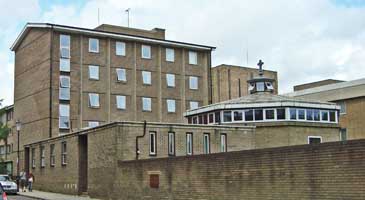
St Wilfrid's Convent and Home in Tite Street. The octagonal chapel has a shallow roof and a small lantern.
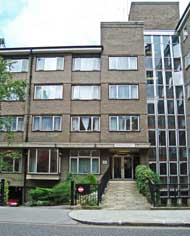
The entrance is at 29 Tite Street.
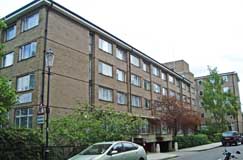
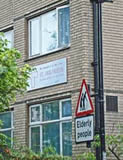
The building is at the corner of Royal Hospital Road and Tite Street.
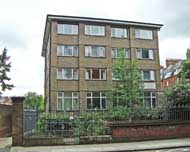
The northern elevation on Royal Hospital Road.
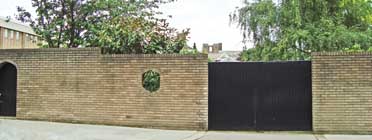
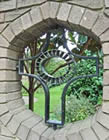
The garden wall along Tite Street (left), with a cruciform view into the garden (right).
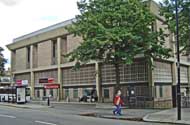
The National Army Museum is next door in Royal Hospital Road.
Annie Zunz Wards
Siegfried Rudolf Zunz, an iron merchant, came to London from
Frankfurt-am-Main in 1860. He married Annie, an Irishwoman, in
1874 but the couple remained childless. In 1896 his wife died.
He was inconsolable and died three years later.
In his will he instructed that his executors and trustees should give
£25,000 (a small fortune then) to a London hospital to build and
maintain a ward named 'The Annie Zunz Ward' in memory of his beloved
wife. A life-size photograph of Annie was to be hung in this
ward. The remainder of his estate, valued at £115,200, was
to be given to other London hospitals to support Annie Zunz Wards.
St Mary's Hospital in Praed Street was selected to receive the £25,000 so that it could complete the Clarence Wing.
Other London hospitals applied to the Zunz trustees for the rest of the
estate and Annie Zunz Wards were established at many of them, including
the Great Ormond Street Hospital, at the Royal Free Hospital, the Fulham Hospital, the Middlesex Hospital, the Evelina Children's Hospital, King's College Hospital, the Chelsea and Westminster Hospital, St John's Hospital for Diseases of the Skin, St Bartholomew's Hospital and the Bolingbroke Hospital, as well as the Victoria Hospital for Children.
Several of these hospitals have closed and, ironically, St Mary's
Hospital, the one to benefit the most from the legacy, no longer has an
Annie Zunz Ward.
References
Rosser EM 1984 Who was Annie Zunz? Annals of the Royal College of Surgeons of England 66, 62.
References
(Author unstated) 1915 News in Brief. The Red Cross 2, 45.
Edwards G 1964 The Victoria Hospital for Children, Tite Street, Chelsea, SW3. A Short Commemorative History 1866-1964. London, St George's Hospital.
www.british-history.ac.uk
www.hospitalshistory.multiply.com
www.rbkc.gov.uk